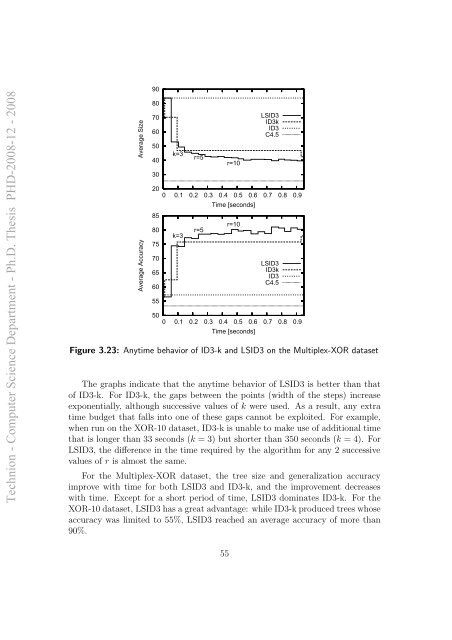anytime algorithms for learning anytime classifiers saher ... - Technion
anytime algorithms for learning anytime classifiers saher ... - Technion
anytime algorithms for learning anytime classifiers saher ... - Technion
You also want an ePaper? Increase the reach of your titles
YUMPU automatically turns print PDFs into web optimized ePapers that Google loves.
<strong>Technion</strong> - Computer Science Department - Ph.D. Thesis PHD-2008-12 - 2008<br />
Average Size<br />
Average Accuracy<br />
90<br />
80<br />
70<br />
60<br />
50<br />
40<br />
30<br />
k=3<br />
r=5<br />
r=10<br />
20<br />
0 0.1 0.2 0.3 0.4 0.5 0.6 0.7 0.8 0.9<br />
85<br />
80<br />
75<br />
70<br />
65<br />
60<br />
55<br />
k=3<br />
r=5<br />
Time [seconds]<br />
r=10<br />
LSID3<br />
ID3k<br />
ID3<br />
C4.5<br />
50<br />
0 0.1 0.2 0.3 0.4 0.5 0.6 0.7 0.8 0.9<br />
Time [seconds]<br />
LSID3<br />
ID3k<br />
ID3<br />
C4.5<br />
Figure 3.23: Anytime behavior of ID3-k and LSID3 on the Multiplex-XOR dataset<br />
The graphs indicate that the <strong>anytime</strong> behavior of LSID3 is better than that<br />
of ID3-k. For ID3-k, the gaps between the points (width of the steps) increase<br />
exponentially, although successive values of k were used. As a result, any extra<br />
time budget that falls into one of these gaps cannot be exploited. For example,<br />
when run on the XOR-10 dataset, ID3-k is unable to make use of additional time<br />
that is longer than 33 seconds (k = 3) but shorter than 350 seconds (k = 4). For<br />
LSID3, the difference in the time required by the algorithm <strong>for</strong> any 2 successive<br />
values of r is almost the same.<br />
For the Multiplex-XOR dataset, the tree size and generalization accuracy<br />
improve with time <strong>for</strong> both LSID3 and ID3-k, and the improvement decreases<br />
with time. Except <strong>for</strong> a short period of time, LSID3 dominates ID3-k. For the<br />
XOR-10 dataset, LSID3 has a great advantage: while ID3-k produced trees whose<br />
accuracy was limited to 55%, LSID3 reached an average accuracy of more than<br />
90%.<br />
55











